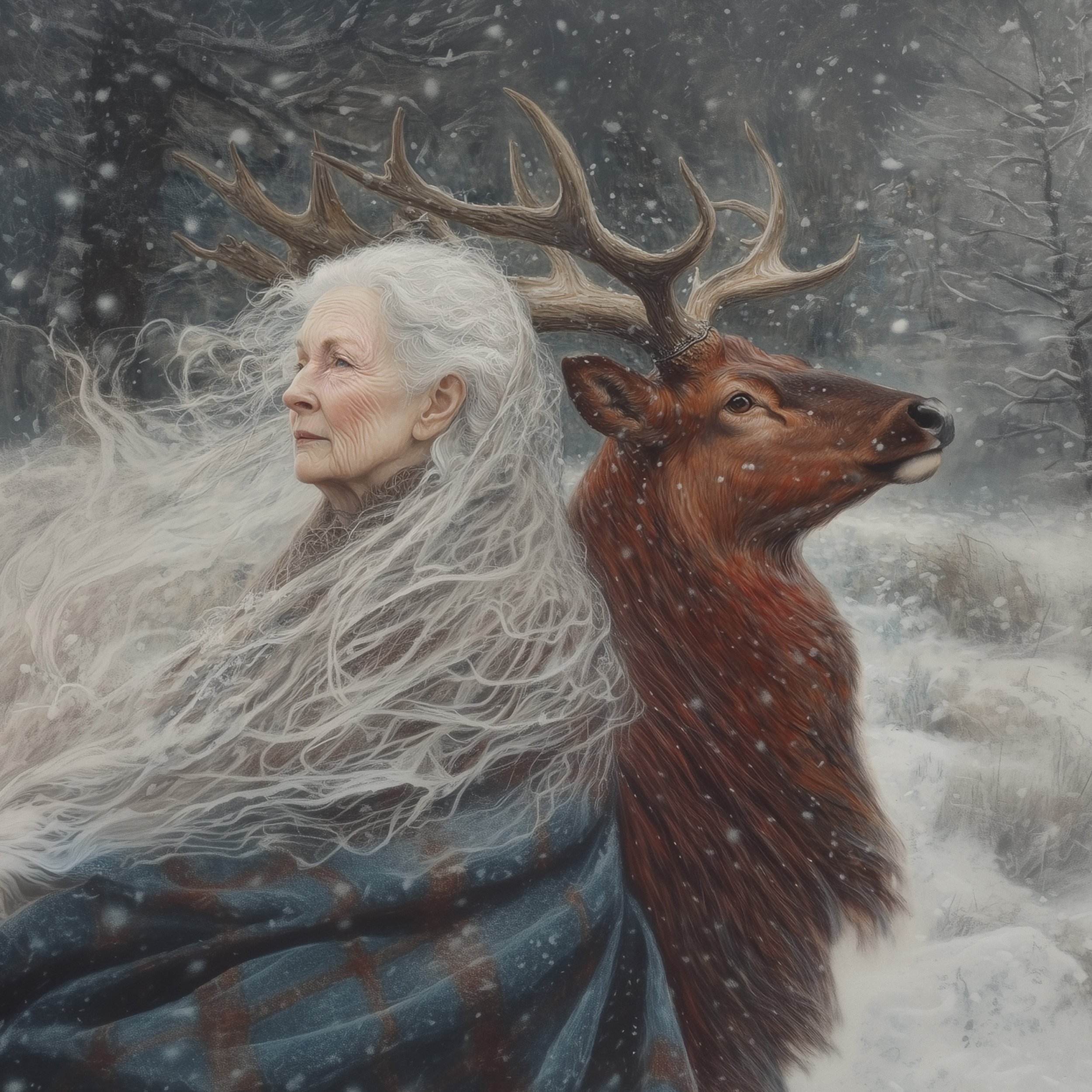The Cailleach

Winter has officially settled into my little neck of the woods here in the Mid-Atlantic, and the Polar Vortex has wrapped the landscape in a blanket of snow and ice. The air is crisp, each breath visible, and the silence of the bone-white stillness invites deep reflection. In these quiet, frigid moments, I feel a profound connection to The Cailleach, known as the Veiled One—an ancient and elemental figure whose myth echoes across the Celtic lands of Scotland and Ireland. The Cailleach is more than a distant myth; she is tangible in the chill that settles over barren fields and frost-laden trees. Believed to be older than time itself, she predates the pantheons of more familiar deities. Some traditions say she was born from the earth’s first breath—a raw manifestation of the primal forces that shaped the world. Others see her as the very personification of the land: unyielding, eternal, and sculpting the world with weathered hands and fierce will. In contrast to goddesses often depicted as young and beautiful, the Cailleach stands firmly as a crone, her face etched with the wisdom of countless winters and her wild white hair braided with echoes of snow and ice. Her age and crone status command a unique reverence for resilience, wisdom, and the raw power of nature.
The Cailleach appears as an awe-inspiring elder woman, a figure weathered by countless winters yet imbued with an enduring, elemental presence. Her face is carved with deep wrinkles and lines that testify to eons of wisdom, each crevice a silent chronicle of the seasons she has witnessed. Her eyes, sharp and penetrating, seem to reflect the icy depths of winter lakes and the vastness of snow-covered plains. Wild white hair flows untamed, often braided with strands that glint like fresh snow and frost—echoing the winter landscapes over which she rules. Her domain is winter itself. As summer yields to autumn and finally to the deep chill of winter, the Cailleach strides across the landscape with her great staff and weathered cloak, summoning ice and snow. She strikes the earth, freezing lakes, thickening the fog, and calling forth storms. Her actions are not born of malice but are necessary expressions of creation and destruction. Legends recount how, in one tale, she scattered stones from her apron to form Scotland’s rugged peaks. As winter’s chill took hold, the Cailleach moved among the hills, and where her apron brushed against the earth, boulders tumbled down, shaping mountains that still dominate the landscape. Rivers and lochs followed her path, forever marking her influence on the land. This tale highlights not only her dominion over the harsh winter elements but also her creative force in sculpting the very earth itself. In a way, the Cailleach is the primordial grandmother of the ancient Celts.
Throughout winter, the Cailleach is often accompanied by the stag—a majestic creature that embodies strength, solitude, and a deep bond with the wild. The stag symbolizes wisdom and resilience, reflecting the Cailleach’s own character. Other animals, such as ravens, owls, and wolves, may also accompany her, each adding layers to her aura of foresight, intuition, and survival against the odds. The stag, in particular, emphasizes her role as a guardian of the wilderness and a symbol of the enduring spirit of winter and the wild. As winter deepens, so does the cyclical nature of her myth. Her powers govern the stark, quiet months when the world lies bare, yet even in this seeming death, life stirs beneath the snow. When the harshest part of winter passes, the land she rules over begins to show signs of renewal. Some traditions speak of her growing weary and her influence receding as she prepares to yield to the coming spring. At this transition, she is often described as shedding her crone form to become Brigid, the radiant maiden of spring—a transformation that marks the passage from winter’s severity to the renewal of life. In other versions, she contends with Brigid, symbolizing the balance and eternal interplay between cold and warmth, stillness and movement, death and rebirth.
The Cailleach’s influence is deeply embedded in ancient culture. For the Celts, she was a powerful symbol of survival and reverence for nature’s harsh truths. Farmers and herders facing the brutal cold would respect her presence and the lessons she imparted. Their rituals were not about lavish offerings but about acknowledging winter’s hardships and seeking wisdom to endure them, honoring the rhythms and realities she embodied. Today, there is a resurgence of interest in the Cailleach among those drawn to nature spirituality and neo-pagan traditions. Her image—an unapologetic crone cloaked in snow and wind, with a face carved by countless winters and wild white hair braided with echoes of snow and ice—stands as a symbol of resilience and wisdom. Modern admiration for the Cailleach emphasizes respect for her enduring power and the lessons embedded in the cycles of nature.
The Cailleach invites us to face the raw truths of existence with courage. She teaches that life involves navigating storms, enduring cold, and emerging stronger on the other side. In her, we find not cruelty but profound clarity—an understanding that every ending births a new beginning. By honoring her crone aspect, we learn to respect the earth in all its phases, appreciate the wisdom that comes with age, and live in harmony with the rhythms of nature. The Cailleach remains as wild and untamed as the landscapes she shaped, a timeless reminder that there is strength in cycles, beauty in the stark and barren, and enduring wisdom in the face of adversity.

